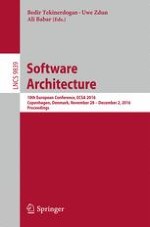2016 | Book
Software Architecture
10th European Conference, ECSA 2016, Copenhagen, Denmark, November 28 -- December 2, 2016, Proceedings
Editors: Bedir Tekinerdogan, Uwe Zdun, Ali Babar
Publisher: Springer International Publishing
Book Series : Lecture Notes in Computer Science
